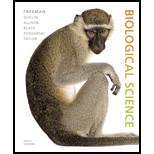
Concept explainers
Introduction:
A mutation refers to the permanent alteration of the DNA (deoxyribonucleic acid) sequence in an organism. The mutations can occur due to the insertion, deletion, or change in the base-pair of the DNA sequence.
Answer to Problem 1TYK
Correct answer:
The change in the base pair during replication process is referred to as a mutation.
Explanation of Solution
Explanation/Justification for the correct answer:
Option (a) is given as a mutation. An alteration in the base-pair of the sequence during the
Explanation for the incorrect answers:
Option (b) is given as mutations that fall in the protein-coding part of the gene. These mutations are known as missense mutations, which also come under mutations only. So, it is an incorrect option.
Option (c) is given as mutation in the transcribed part of the genome. Even, if the mutation does not fall in the protein-coding part or in the transcribed part of the genome, it would still be called as a mutation. So, it is an incorrect option.
Option (d) is given as single base-pair change is not considered as mutation. A change in a single base-pair has the potential to change the whole DNA sequence. Hence, a single base-pair change is also considered as a mutation. So, it is an incorrect option.
Hence, the options (b), (c), and (d) are incorrect.
A mutation is an alteration in the genome. The change in the base-pair of the DNA sequence is always considered as a mutation, no matter where it is present.
Want to see more full solutions like this?
Chapter 16 Solutions
Biological Science (6th Edition)
- Addition or deletion of bases causes which kind of mutation? Select one: a. Frameshift mutation b. Transversion c. Transition d. Transcriptionarrow_forwardA promoter is ______. a. a specific sequence of DNA nucleotides b. a specific sequence of RNA nucleotides c. a protein that binds to DNA d. an enzyme that synthesizes RNAarrow_forwardThe original DNA base sequence is 5’-AGCGTTACCGT-3’; a mutation in the DNA strand results in the base sequence 5’-AGGCGTTACCGT-3’. What can you conclude about the mutation? A. It is a frameshift mutation. B. It is a silent mutation. C. It is a deleterious mutation. D. It may result in a single amino acid change in the protein being coded for by this base sequence.arrow_forward
- Which among the following statements is not true about mutations? * a.) It may either occur at the chromosomes or at the sequence of nucleic acids. b.) It is caused either by mutagens or through hereditary genes. c.) All mutations cause diseases and disorders in the developing organism. d.) All mutations causes a change in the structure or sequence of the genetic material.arrow_forwardMutagens can cause mutations bya. chemically altering DNA nucleotides.b. disrupting DNA replication.c. altering the genetic code of an organism.d. all of the above.e. a and b only.arrow_forwardWhich of the following is true of reverse transcriptase?a. It is required for the movement of DNA transposons.b. It catalyzes the synthesis of DNA from RNA.c. It is required for the transposition of retrotransposons.d. b and c are correct.arrow_forward
- Which type of mutation produces the same protein despite a change in the DNA? A. nonsense B. missense C. silent D. frameshiftarrow_forwardWhy are mutations more likely to occur in repeated DNA sequences? a. These bases are unstable b. bases in the strand can form base pairs, generating loops that interfere with replication and repair enzymes. c. The repeats hold onto the replication enzymes, causing base mismatches d. the repeats attract and bind to mutagens, increasing the mutation ratearrow_forwardA large portion of the human genome is transposons. Collectively, they are most likely: A) an equal mix of DNA and retrotransposons B) mostly DNA transposons because they are found in DNA C) mostly retrotransposons because they copy themselves each time they move D) mostly DNA transposons because they can cut themselves outarrow_forward
- Refer to Figure 2 and compare this with the DNA model in Figure 1. a. In what ways are they similar? b. In what ways are they different? c. What is the biological significance of such differences? Why is the DNA referred to as the genetic material?arrow_forward_____ is a change in the order of one nucleotide in a section of a DNA molecule. a Point mutation b Spontaneous mutation c Somatic mutation d Germ mutationarrow_forwardWhich of the following is not a factor that increases mutations? A. replication errors B. ionizing radiation C. UV radiation D. repair enzymesarrow_forward
 Human Biology (MindTap Course List)BiologyISBN:9781305112100Author:Cecie Starr, Beverly McMillanPublisher:Cengage Learning
Human Biology (MindTap Course List)BiologyISBN:9781305112100Author:Cecie Starr, Beverly McMillanPublisher:Cengage Learning Concepts of BiologyBiologyISBN:9781938168116Author:Samantha Fowler, Rebecca Roush, James WisePublisher:OpenStax College
Concepts of BiologyBiologyISBN:9781938168116Author:Samantha Fowler, Rebecca Roush, James WisePublisher:OpenStax College

